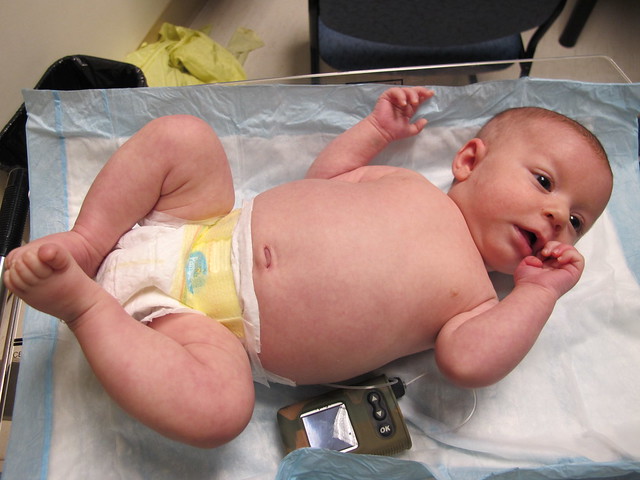On November 9th, 2011, when Aedan was almost 7 weeks old, he became very sick over night. As new parents, we were afraid of over-reacting. We didn't want to rush him to the nursing station in town if he only had bad gas, or a bug.
But by early morning, it was obvious that this wasn't normal. He was dehydrated, unable to nurse, completely lethargic, and his breathing was laboured. We took him to the nursing station, where they quickly got him on I.V. fluids to begin rehydrating him. While examining him, my doctor noticed that his breath smelled unusually sweet, an indicator of ketones in the blood. She tested his blood-glucose (BG) level: it was so high that it wouldn't register on the meter. She got on the phone with first the Whitehorse General hospital, and then with the B.C. Women and Children's hospital in Vancouver. We were told that Aedan was in a state of diabetic ketoacidocis, and would be med-evaced (sent by plane) to the pediatric intensive care unit in Vancouver.
He spent 2 days in intensive care, where the doctors brought his body back into stasis; and another 3 days under close observation. He was put on an insulin pump, and we spent the week learning about diabetes and how to use the pump. It was an intense, overwhelming time, and hard to comprehend everything that was happening. There is no diabetes in either of our families, and Aedan seemed too young to develop juvenile Type 1 diabetes. We were told he most likely had neo-natal diabetes, which can mean many different things.

Aedan in the hospital, with his new pump.
Eventually, we received the results of a DNA test: Aedan's particular form of neo-natal diabetes is due to a genetic mutation which blocks the potassium channels in his pancreas. These channels play a critical role in the release of insulin into the bloodstream. Aedan is capable of producing insulin, but with the potassium channels blocked, it wasn't able to do its job. This particular mutation is recognized and has been documented before, and has been successfully managed with oral medication which basically allows the pancreas to function like normal. In January 2012, we began to transition Aedan off of his insulin pump and onto Glyburide. We have since then been successfully managing his diabetes with 5 mg of Glyburide per day.
Aedan's condition is confusing to some: it sort of sounds like he doesn't have diabetes, especially because he can now produce his own insulin. But if he stopped taking the Glyburide, he would become life-threateningly ill. He will always need to either take this pill, or give himself insulin by injection. Should he have children some day, they will have a 50% chance of being born with this form of diabetes, too.
It has changed all of our lives in many ways. I'm sure a day will come when Aedan has many questions that will be hard for us to answer. I hope that I can guide him through any confusion or anger he may feel at this random mutation with grace, so that he can keep on living a full, happy, normal life.
Aedan's form of diabetes is quite uncommon: I would be so glad to connect with other families going through a similar experience. Please don't hesitate to leave a comment here or email me: tara dot borin at gmail dot com.
I want to thanks for your time for this wonderful Article!! I definitely enjoying every little bit of it and I have you bookmarked to check out new stuff you blog post.
ReplyDeleteI think you should write more on this topic. Keep it up.
ReplyDelete